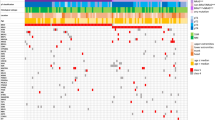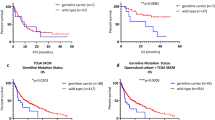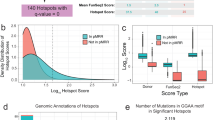Abstract
Germline mutations of CDKN2A that affect the p16INK4a transcript have been identified in numerous melanoma pedigrees worldwide. In the UK, over 50% of pedigrees with three or more cases of melanoma have been found to carry mutations of CDKN2A. Mutations that affect p14ARF exon 1β exclusively are very rare. This has led to the suggestion that it is p16INK4a and not p14ARF that plays the critical role in melanoma predisposition. We report the identification of a cluster of five different germline mutations at the p14ARF exon 1β splice donor site in melanoma pedigrees. All the five splice site variants showed evidence of being causal mutations. Three of the variants were demonstrated to result in aberrant splicing of the p14ARF mRNA, confirming their role in melanoma predisposition. No other point mutations were identified in the coding region of p14ARF. The p14ARF transcript of CDKN2A is clearly important in disease predisposition in a subset of melanoma pedigrees. Curiously, the only mutations so far reported to affect p14ARF exon 1β exclusively have been knockout mutations. Further investigation into the spectrum of mutations observed in this gene may help clarify the exact role of p14ARF in melanoma predisposition.
This is a preview of subscription content, access via your institution
Access options
Subscribe to this journal
Receive 50 print issues and online access
$259.00 per year
only $5.18 per issue
Buy this article
- Purchase on Springer Link
- Instant access to full article PDF
Prices may be subject to local taxes which are calculated during checkout



Similar content being viewed by others
References
Alcorta DA, Xiong Y, Phelps D, Hannon G, Beach D and Barrett JC . (1996). Proc. Natl. Acad. Sci. USA, 93, 13742–13747.
Bennett DC . (2003). Oncogene, 22, 3063–3069.
Bishop DT, Demenais F, Goldstein AM, Bergman W, Bishop JN, Bressac-de Paillerets B, Chompret A, Ghiorzo P, Gruis N, Hansson J, Harland M, Hayward N, Holland EA, Mann GJ, Mantelli M, Nancarrow D, Platz A and Tucker MA . (2002). J. Natl. Cancer Inst., 94, 894–903.
Clurman BE and Groudine M . (1998). N. Engl. J. Med., 338, 910–912.
den Dunnen JT and Antonarakis SE . (2001). Hum. Genet., 109, 121–124.
Dracopoli NC and Fountain JW . (1996). Cancer Surv., 26, 115–132.
Goldstein AM, Struewing JP, Chidambaram A, Fraser MC and Tucker MA . (2000). J. Natl. Cancer Inst., 92, 1006–1010.
Haber DA . (1997). Cell, 91, 555–558.
Hara E, Smith R, Parry D, Tahara H, Stone S and Peters G . (1996). Mol. Cell. Biol., 16, 859–867.
Harland M, Holland EA, Ghiorzo P, Mantelli M, Bianchi-Scarra G, Goldstein AM, Tucker MA, Ponder BA, Mann GJ, Bishop DT and Newton Bishop J . (2000). Genes Chromosomes Cancer, 28, 45–57.
Harland M, Meloni R, Gruis N, Pinney E, Brookes S, Spurr NK, Frischauf AM, Bataille V, Peters G, Cuzick J, Selby P, Bishop DT and Bishop JN . (1997). Hum. Mol. Genet., 6, 2061–2067.
Harland M, Taylor CF, Bass S, Churchman M, Randerson-Moor J, Holland EA, Mann GJ, Bishop DT and Newton Bishop JA . (2005). Genes Chromosomes Cancer, 43, 128–136.
Hayward NK . (1996). Curr. Opin. Oncol., 8, 136–142.
Hewitt C, Lee Wu C, Evans G, Howell A, Elles RG, Jordan R, Sloan P, Read AP and Thakker N . (2002). Hum. Mol. Genet., 11, 1273–1279.
Hilleren PJ and Parker R . (2003). Mol. Cells, 12, 1453–1465.
Huot TJ, Rowe J, Harland M, Drayton S, Brookes S, Gooptu C, Purkis P, Fried M, Bataille V, Hara E, Newton-Bishop J and Peters G . (2002). Mol. Cell. Biol., 22, 8135–8143.
Jones AC, Austin J, Hansen N, Hoogendoorn B, Oefner PJ, Cheadle JP and O'Donovan MC . (1999). Clin. Chem., 45, 1133–1140.
Meyerhans A, Vartanian JP and Wain-Hobson S . (1990). Nucleic Acids Res., 18, 1687–1691.
Mount SM . (1982). Nucleic Acids Res., 10, 459–472.
Paabo S, Irwin DM and Wilson AC . (1990). J. Biol. Chem., 265, 4718–4721.
Parker R and Siliciano PG . (1993). Nature, 361, 660–662.
Quelle DE, Zindy F, Ashmun RA and Sherr CJ . (1995). Cell, 83, 993–1000.
Randerson-Moor JA, Harland M, Williams S, Cuthbert-Heavens D, Sheridan E, Aveyard J, Sibley K, Whitaker L, Knowles M, Newton Bishop J and Bishop DT . (2001). Hum. Mol. Genet., 10, 55–62.
Reese MG, Eeckman FH, Kulp D and Haussler D . (1997). J. Comput. Biol., 4, 311–323.
Rizos H, Puig S, Badenas C, Malvehy J, Darmanian AP, Jimenez L, Mila M and Kefford RF . (2001). Oncogene, 20, 5543–5547.
Robertson KD and Jones PA . (1999). Oncogene, 18, 3810–3820.
Roussel MF . (1999). Oncogene, 18, 5311–5317.
Shapiro MB and Senapathy P . (1987). Nucleic Acids Res., 15, 7155–7174.
Sharpless NE and DePinho RA . (1999). Curr. Opin. Genet. Dev., 9, 22–30.
Sherr CJ . (2001). Nat. Rev. Mol. Cell Biol., 2, 731–737.
Stone S, Jiang P, Dayananth P, Tavtigian SV, Katcher H, Parry D, Peters G and Kamb A . (1995). Cancer Res., 55, 2988–2994.
Tarn WY and Steitz JA . (1996). Cell, 84, 801–811.
Zaphiropoulos PG . (1998). Nucleic Acids Res., 26, 2843–2848.
Zuo L, Weger J, Yang Q, Goldstein AM, Tucker MA, Walker GJ, Hayward N and Dracopoli NC . (1996). Nat. Genet., 12, 97–99.
Acknowledgements
We thank Linda Whitaker, Elizabeth Pinney, Veronique Bataille, Karen Griffiths, JM (Bee) Squire, Patricia Mack and Rachel Wachsmuth, who were involved in interviewing patients in the English familial melanoma research programme since 1989. We are very grateful to the families who took part, without whose gift of time and information this research would not have taken place. We are also grateful to the Clare Hall Cell Service facility and to Sharon Jackson for providing the lymphoblastoid cell lines. This work was funded by Cancer Research UK in the United Kingdom and was supported by NIH award IR01 CA083115.
Author information
Authors and Affiliations
Corresponding author
Rights and permissions
About this article
Cite this article
Harland, M., Taylor, C., Chambers, P. et al. A mutation hotspot at the p14ARF splice site. Oncogene 24, 4604–4608 (2005). https://doi.org/10.1038/sj.onc.1208678
Received:
Revised:
Accepted:
Published:
Issue Date:
DOI: https://doi.org/10.1038/sj.onc.1208678
Keywords
This article is cited by
-
CDKN2A germline alterations and the relevance of genotype-phenotype associations in cancer predisposition
Hereditary Cancer in Clinical Practice (2021)
-
A Flexible Multiplex Bead-Based Assay for Detecting Germline CDKN2A and CDK4 Variants in Melanoma-Prone Kindreds
Journal of Investigative Dermatology (2011)
-
Absence of Germline Epimutation of the CDKN2A Gene in Familial Melanoma
Journal of Investigative Dermatology (2009)
-
Prevalence of variations in melanoma susceptibility genes among Slovenian melanoma families
BMC Medical Genetics (2008)
-
Clinical and Molecular Characterization of Patients at Risk for Hereditary Melanoma in Southern Brazil
Journal of Investigative Dermatology (2008)



